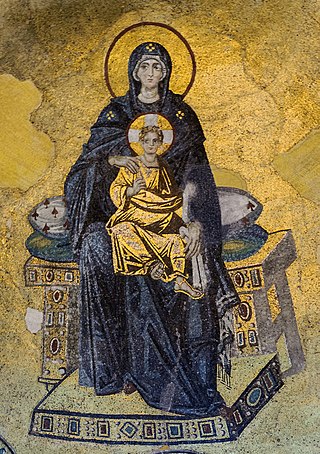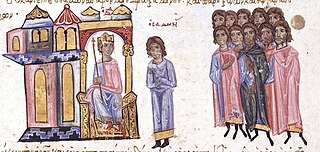
Photios I, also spelled Photius, was the ecumenical patriarch of Constantinople from 858 to 867 and from 877 to 886. He is recognized in the Eastern Orthodox Church as Saint Photios the Great.

Leo V the Armenian was the Byzantine emperor from 813 to 820. A senior general, he forced his predecessor, Michael I Rangabe, to abdicate and assumed the throne. He ended the decade-long war with the Bulgars, and initiated the second period of Byzantine Iconoclasm. He was assassinated by supporters of Michael the Amorian, one of his most trusted generals, who succeeded him on the throne.

Theodosius III was Byzantine emperor from c. May 715 to 25 March 717. Before rising to power and seizing the throne of the Byzantine Empire, he was a tax collector in Adramyttium. In 715, the Byzantine navy and the troops of the Opsician Theme, one of the Byzantine provinces, revolted against Emperor Anastasius II, acclaiming the reluctant Theodosius as emperor. Theodosius led his troops to Chrysopolis and then Constantinople, the capital, seizing the city in November 715. Anastasius did not surrender until several months later, accepting exile in a monastery in return for safety. Many themes viewed Theodosius to be a puppet of the troops of the Opsician Theme, and his legitimacy was denied by the Anatolics and the Armeniacs under their respective strategoi (generals) Leo the Isaurian and Artabasdos.

Michael I Rangabé was Byzantine emperor from 811 to 813.

Germanus I was the Patriarch of Constantinople from 715 to 730. He is regarded as a saint by both the Orthodox and Roman Catholic Churches, with a feast day of 12 May. He had been ecumenically preceded by Patriarch John VI of Constantinople, and was succeeded in Orthodox Rite by Patriarch Constantine II of Constantinople.

Tiberius III, born Apsimar, was Byzantine emperor from 698 to 705. Little is known about his early life, other than that he was a droungarios, a mid-level commander, who served in the Cibyrrhaeot Theme. In 696, Tiberius was part of an army sent by Byzantine Emperor Leontius to retake the North African city of Carthage, which had been captured by the Arab Umayyads. After seizing the city, this army was pushed back by Umayyad reinforcements and retreated to the island of Crete. As they feared the wrath of Leontius, some officers killed their commander, John the Patrician, and declared Tiberius the emperor. Tiberius swiftly gathered a fleet and sailed for Constantinople, where he then deposed Leontius. Tiberius did not attempt to retake Byzantine Africa from the Umayyads, but campaigned against them along the eastern border with some success. In 705, former emperor Justinian II, who had been deposed by Leontius, led an army of Slavs and Bulgars from the First Bulgarian Empire to Constantinople, and after entering the city secretly, deposed Tiberius. Tiberius fled to Bithynia, but was captured a few months later and beheaded by Justinian between August 705 and February 706. His body was initially thrown into the sea, but was later recovered and buried in a church on the island of Prote.
This is an alphabetical index of people, places, things, and concepts related to or originating from the Byzantine Empire. Feel free to add more, and create missing pages. You can track changes to the articles included in this list from here.

Eudokia Makrembolitissa was a Byzantine empress by her successive marriages to Constantine X Doukas and Romanos IV Diogenes. She acted as regent of her minor son, Michael VII in 1067, and resigned her regency by marriage to Romanos IV Diogenes. When he was deposed in 1071 she resumed the regency for her sons, but was soon forced to resign again.

Macedonian Renaissance is a historiographical term used for the blossoming of Byzantine culture in the 9th–11th centuries, under the eponymous Macedonian dynasty (867–1056), following the upheavals and transformations of the 7th–8th centuries, also known as the "Byzantine Dark Ages". The period is also known as the era of Byzantine encyclopedism, because of the attempts to systematically organize and codify knowledge, exemplified by the works of the scholar-emperor Constantine VII Porphyrogennetos.

The Joshua Roll is a Byzantine illuminated manuscript of highly unusual format, probably of the 10th century Macedonian Renaissance, believed to have been created by artists of the imperial workshops in Constantinople, and now in the Vatican Library.
Joseph Bringas was an important Byzantine eunuch official in the reigns of Emperor Constantine VII and Emperor Romanos II, serving as chief minister and effective regent during the latter. Having unsuccessfully opposed the rise of Nikephoros Phokas to the imperial throne in 963, he was exiled to a monastery, where he died in 965.
Stylianos Zaoutzes was a high Byzantine official of Armenian origin. Rising to high rank under Byzantine emperor Basil I, he then rose further to prominence under Basil's successor Emperor Leo VI the Wise, who had a close friendship and possibly an affair with Stylianos's daughter Zoe Zaoutzaina. Stylianos Zaoutzes was Leo's leading minister during the first half of his reign, and was awarded the unique title of basileopator. His standing and influence declined after 895, but in 898, he became Leo's father-in-law when the Byzantine emperor married Zoe. He died in 899, in the same year as Zoe. Following an attempted coup by his relatives, the Zaoutzes clan was deprived of the considerable power it had amassed under Stylianos's tutelage.

Samonas was an Arab eunuch, who was captured by the Byzantines and became one of the most influential officials of the Byzantine Empire during the first decade of the 10th century.

The Menologion, Menologium, or Menology of Basil II is an illuminated manuscript designed as a church calendar or Eastern Orthodox Church service book (menologion) that was compiled c. 1000 AD for the Byzantine Emperor Basil II. It contains a synaxarion, a short collection of saints' lives, compiled at Constantinople for liturgical use and around 430 miniature paintings by eight different artists. It was unusual for a menologion from that era to be so richly painted. It currently resides in the Vatican Library . A full facsimile was produced in 1907.
Sergios Niketiates was a senior Byzantine official and member of the Amorian dynasty. He is celebrated as a saint by the Eastern Orthodox Church on 28 June for his role in the restoration of the veneration of icons.
Gregoras Iberitzes was a Byzantine nobleman and senior military leader of the early 10th century.
Damian was a senior Byzantine eunuch official during the reign of Emperor Michael III (842–867), serving as the head chamberlain (parakoimomenos) to the emperor.

Thekla, Latinized as Thecla, was a princess of the Amorian dynasty of the Byzantine Empire. The daughter and eldest child of Byzantine emperor Theophilos and empress Theodora, she was proclaimed augusta in the late 830s. After Theophilos's death in 842 and her mother becoming regent for Thekla's younger brother Michael III, Thekla was associated with the regime as co-empress alongside Theodora and Michael.

Constantine was a junior Byzantine emperor, alongside Basil I as the senior emperor, from January 868 to 3 September 879. His parentage is a matter of debate, but historians generally assume him to be the son of Emperor Basil I and his first wife Maria or second wife Eudokia Ingerina; other theories include him being the son of Emperor Michael III and Eudokia. Constantine was made co-emperor by Basil in c. January 868. He was engaged to Ermengard of Italy, the daughter of Holy Roman Emperor Louis II, in 870/871, but it is not known if he married her; some sources suggest he did, and others argue that there is no concrete evidence.

Codex Mutinensis graecus 122 is a 15th-century codex written in Greek, today stored in the Biblioteca Estense in Modena, Italy. The designation Mutinensis gr. 122 is modern and the codex itself bears the title Epitome of Histories as the bulk of its content is made up of a copy of large parts of the 12th-century Byzantine historian Joannes Zonaras's Epitome of Histories.














